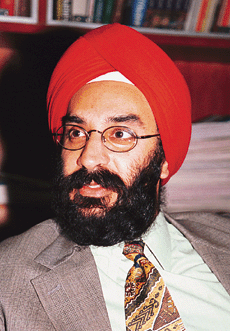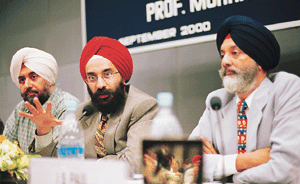‘Punjab should be like Mac, not Unix’
By Roopinder Singh
Mohanbir Sawhney is one of the most influential persons in the world of e-business. A widely respected and published man, Sawhney was in Chandigarh recently where he met business leaders and government officials. Before arriving in Chandigarh, Sawhney, who has been listed as one of the 25 most influential men in e-commerce in the world by Business Week magazine, had delivered a keynote address at the India Internet World exhibition in New Delhi. Sawhney touched on various aspects of economy and IT during an exclusive interview. Excerpts:
 Which are the areas the youngsters should start aiming for careers in IT?
Which are the areas the youngsters should start aiming for careers in IT?
If you start looking at the school level, computer training has been added to the general reading, writing and arithmetic, because it has become an essential skill now. Not that everybody is going to become a software programmer, but because everybody will have to learn how to live with and intelligently learn how to use technology. I don’t think that children have any problem; they take to it like a duck takes to water. All that you have to do is to provide computers and connectivity. You have to make sure that you are not creating a digital divide, because tomorrow, as it becomes an essential skill, then, if we do not have universal access in the schools, public libraries and other public instructions, then those people would be left behind.
As people go into professional education, while IT will still remain, in terms of percentage, not the bulk of the economy, at the same time some of the highest value jobs will be created in this sector and will be responsible for a significant part of the growth. For instance, in the USA now, IT accounts for almost 25 per cent of the GDP growth even though it is only 10 per cent of the GDP.
People who are looking at attractive career options have a whole set of attractive options around IT, whether it is programming-related, development jobs, call centres, medical transcription etc. There will be a sub-set of these people as entrepreneurs, who will need to be taught about various aspects of entrepreneurship, finance, marketing etc.
What has been the level of Punjabi success stories in IT in the USA?
Anecdotal evidence is that when Business Week named 25 of the most influential persons in e-business, there were three Indians, one was a Khosla, one was a Sidhu and the third was Sawhney. (Vinod Khosla was the founder of Sun, and Sanjeev Sidhu is the CEO of I2 Technologies) If you look at the Silicon Valley, Punjabis have more than their share of proportional representation at the top. By all means, they are leading the revolution. The founder of fibre optics is Dr Narinder Singh Kampani.
What technologies should youngsters focus on?
Data base technologies is one area that will continue to be very fundamental. Oracle will be leading the pack there. There are specific areas in e-business in which some companies are emerging as leaders. You have BEA (http://www.bea.com) in the application server business, Vignette in the content management business, BroadVision in e-commerce.
It’s difficult to think about the future, but you have to focus leading companies like Microsoft (http://www.microsoft.com/), Oracle (http://www.oracle.com/), Vignette (http://www.Vignette.com/), BroadVision (http://www.broadvision.com).
 In the emerging new economy what is the role that a government should play?
In the emerging new economy what is the role that a government should play?
The optimal role for the government is actually no role. I would not go to the extreme of saying that government should go out of the business. The government needs to play the role of a gardener—to create the right environment, to protect the flowers from pests—but then you have to let the flowers bloom. You don’t micro-manage, you don’t watch each flower bloom because a watched flower doesn’t bloom. The Chief Ministers have to start thinking as if they are managing an enterprise. We have to think in terms of Punjab Inc. We can learn from people like Le Kuan Yeu in Singapore and Chandrababu Naidu.
What does all this mean to the common man? Will this have a trickle-down effect?
I think that one of the things that we have to think about is the process of using technology for governance—e-governance. As Chandrababu Naidu says, “The state of the art can be used to re-invent that art of the state.”
What does it mean? It means improving the delivery of government services — basic services like registration of land, vehicular transfers, birth/death registrations etc. All basic government services can be delivered through kiosks set up in villages. The interaction between the districts and the state capital can be done through networks.
Investment will come when capital is welcomed and is assured of transparency. I think that the big problem that one bumps into is vested interests that protect the status quo. Transparency is not good for corruption. You automat all these activities and what happens to the person who gets Rs 100 for facilitating, say, a driving licence? There will be a lot of resistance. So you need a tremendous amount of political will to impose such reforms.
It is not going to be easy. There are going to be disruptions. Everybody likes to protect his or her existing way of living but it is necessary to change because the cost of failure is high. Even if Punjab is an industrial leader, you might be called an industrial backlog because the rest of the world has moved on.
What is the role of IT in agriculture?
Let me tell you about the little experiment that was tried in the Czech Republic where farming technology is quite limited but people there are well educated and reasonably smart. One of the agri-chemical companies there wanted to sell more pesticide and seeds.
They worked with the state to create a network and a system for the farmers where they gave computers to the farmers and created a network. Therefore, the farmers could use the system to plan their crops. They used remote sensing and satellite technology to map each field and figure out what nutrients and fertilisers were needed and the exact seeding patterns to maximise the production. The farmers used the access to all this data to model the crop patterns. They used it to optimise the mix and as a result these farmers are some of the most intensive Internet users in the world. They have formed virtual communities where they talk to each other and this has really revolutionised how farms operate in the country.
By using the Internet as a means of improving the communication between the growers, agriculture producers and the market places, the agriculture supply chain holds a lot of potential. So it is not something for the few, of the few. There are creative ways in which it can be used to improve life on the whole. Agriculture Revolution led to the Industrial Revolution that led to the Information Revolution and now it can improve agricultural production.
 How should the state be positioned?
How should the state be positioned?
While we should learn from the states that are ahead of us, we should not copy them. We have to find our own road because the skill sets and the capabilities that are represented here are unique—the context is different. We have to see what are capabilities are and focus on them.
Even in the USA, there are regions that try to be like Silicon Valley because the unique conditions that exist in Silicon Valley don’t exist anywhere. You have to find new niches.
Take the example of Ireland. They have become world leaders in outsourced services like Web hosting. Why can’t we take a lead in creating customer call centre?
One other area is for small and medium enterprises. There are vast opportunities for custom manufacturing — linking suppliers here via the Internet to manufacturers in the USA. Two of my students, both Punjabis, have started a company called Capacity Web (http://www.capacityweb.com) which goes to large manufactures like Caterpillar and find for them suppliers who can come up with new manufactured products. The government could play a role in helping the manufacturers get the infrastructure they need to go up to the international level of certification.
These small manufacturers do not even need to be computerised because somebody (an IT-enabled somebody) on a motor cycle could make a round of these suppliers and help them with whatever is needed. It’s quite easy and cheap. Punjab can become the virtual manufacturing enterprise for a wide variety of manufacturers in the USA that are outsourcing their production.
We need to look at traditional strengths in manufacturing and connect people with their market places.
Some manufacturing facilities have become obsolescent, and will need input, both in terms of knowledge, connectivity and upgrading of processes. We have good people and the entrepreneurial spirit and we have to invest in that.
What would it take for Punjab to regain its leadership role?
There is no lack of entrepreneurial spirit or talent. Capital needs to be assured that the rules will be known; they will be fair and will not change. That the bureaucracy will assist and not get in the way and the political leadership will be firm and will have the will. Capital that flows in has to have sovereign guarantees.
If you look at the people who are creating optical fibre technology, e-commerce businesses and venture capitalists, they are Punjabis. But they have not woken up to the fact that they are Punjabis because Punjab is very distant to them. People associate Punjab with economic problems and instability. There should be a public relations campaign, not via a company, but through every individual who travels abroad. When people come to Punjab, they have to experience a different atmosphere, sense the new willingness to work with the private sector and the industry. Punjabis abroad are willing to contribute, but you have to make it easy for them. Punjab has to become a user-friendly state. It should be like Macintosh and not like Unix. You have to create user interfaces, institutional interfaces with entrepreneurs and investors that are consistent and persistent.
You have to behave like marketers. You have to get your act together. Punjab has an image problem. There is not much to gain by beating up on competitors, especially when they are ahead. We have to say how good we really are, kind of “those guys are great, we are great too.”
What is the potential of e-commerce in India?
Consumer-commerce has very limited potential in India over the foreseeable future. If you are a company, I would advice you not to look downstream, but look upstream. Don’t think of selling stuff to consumers, but think of how to make and source things. Think of the supply side and think of manufacturing because that is business-to-business connectivity and businesses are more connected than consumers are.
What areas should the focus be on?
There is a whole revolution that is taking place in the USA — the e-services revolution. We have a huge advantage because our people speak English and can support customers in the USA and in Europe. The old paradigm was body shopping. You don’t need to do it any longer, now brains can be exported over the Net. The first generation of IT services companies that we saw were primarily body shops. The next level is to start getting into managing projects by creating business development and marketing teams in the USA and keeping the production, operations and R&D outfit in India.
If you are an entrepreneur who wants to get involved in software development, keep a very clear vision of how you will keep climbing the food chain. It is very easy to be satisfied at the lower level. The margins are good, you are growing but you are not evolving. You need to keep on moving up the food chain, you move up to projects and then you move up to products. You will eventually become a global company whose base is India but which sees the world as its market.
What about the problems in the educational system?
What do you pay the teachers? Indian universities do not seem to understand the quality equation that is very simple. If your say “I own 100 per cent of your time and anything that you do outside I will tax at 70-80 per cent, I will not work.” You are placing punitive tax rates on external compensation and so there is motivation to go out in the world, to compete and bring that learning back to the classrooms. That is something that you have to learn from the American universities.
If my university had to pay for all my time they would have to pay me $ 3 million! By allowing consulting outside, the benefit flows back to the university, though it happens in a non-linear way.When I make money outside, people are paying me real money for real stuff. I am adding value, I am being tested in the market place and I bring that learning in classrooms.
You have to rethink the compensation system, but it would be too expensive because you can’t take up the salaries 10 times. Let people work outside as long as they fulfil the university requirements. Let people free, especially in business and engineering schools. These are applied fields, and if you let people free, they will be able to bring value to their institutions.
